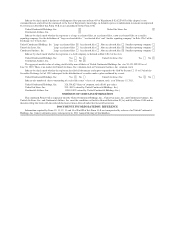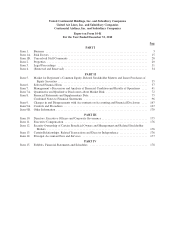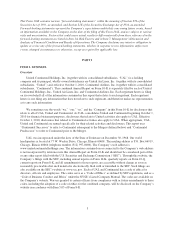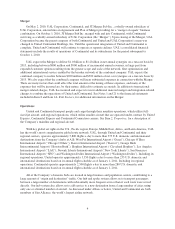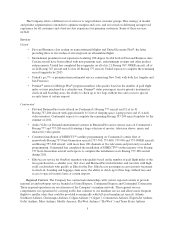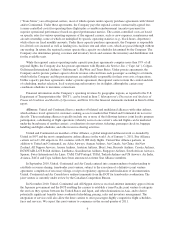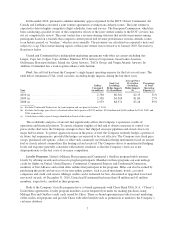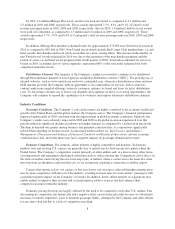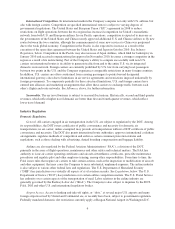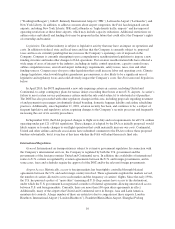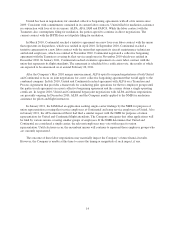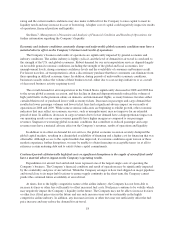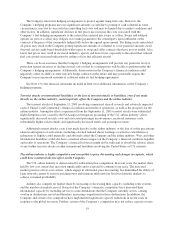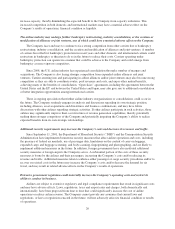United Airlines 2010 Annual Report Download - page 12
Download and view the complete annual report
Please find page 12 of the 2010 United Airlines annual report below. You can navigate through the pages in the report by either clicking on the pages listed below, or by using the keyword search tool below to find specific information within the annual report.(“Washington Reagan”), John F. Kennedy International Airport (“JFK”), LaGuardia Airport (“LaGuardia”) and
New York Liberty. In addition, to address concerns about airport congestion, the FAA has designated certain
airports, including New York Liberty, JFK and LaGuardia as “high density traffic airports” and has imposed
operating restrictions at these three airports, which may include capacity reductions. Additional restrictions on
airline routes and takeoff and landing slots may be proposed in the future that could affect the Company’s rights
of ownership and transfer.
Legislation. The airline industry is subject to legislative activity that may have an impact on operations and
costs. In addition to federal, state and local taxes and fees that the Company is currently subject to, proposed
taxes and fees are currently pending that may increase the Company’s operating costs if imposed on the
Company. Congress is currently attempting to pass comprehensive reauthorization legislation to impose a new
funding structure and make other changes to FAA operations. Past aviation reauthorization bills have affected a
wide range of areas of interest to the industry, including air traffic control operations, capacity control issues,
airline competition issues, aircraft and airport technology requirements, safety issues, taxes, fees and other
funding sources. Congress may also pass other legislation that could increase labor and operating costs. Climate
change legislation, which would regulate greenhouse gas emissions, is also likely to be a significant area of
legislative and regulatory focus and could adversely impact the Company’s costs. See Environmental Regulation,
below.
In April 2010, the DOT implemented a new rule requiring certain air carriers, including United and
Continental, to adopt contingency plans for tarmac delays exceeding three hours at most U.S. airports. A carrier’s
failure to meet certain service performance criteria under the rule could subject it to substantial civil penalties.
The DOT has also proceeded with other regulatory changes in this area, including proposals regarding treatment
of and payments to passengers involuntarily denied boarding, domestic baggage liability and airline scheduling
practices. Additionally, since September 11, 2001, aviation security has been, and continues to be, a subject of
frequent legislative and regulatory action, requiring changes to the Company’s security processes and frequently
increasing the cost of its security procedures.
In September 2010, the FAA proposed changes to flight crew duty and rest requirements for all U.S. airlines
operating under part 121 of FAA regulations. These changes, if adopted by the FAA as initially proposed, would
likely require us to make changes to our flight operations that could materially increase our costs. Continental,
United and other airlines and trade associations have submitted comments to the FAA to reduce these proposed
burdens substantially, but it is unclear at this time whether the FAA will adopt them in its final rule.
International Regulation.
General. International air transportation is subject to extensive government regulation. In connection with
the Company’s international services, the Company is regulated by both the U.S. government and the
governments of the foreign countries United and Continental serve. In addition, the availability of international
routes to U.S. carriers is regulated by aviation agreements between the U.S. and foreign governments, and in
some cases, fares and schedules require the approval of the DOT and/or the relevant foreign governments.
Airport Access. Historically, access to foreign markets has been tightly controlled through bilateral
agreements between the U.S. and each foreign country involved. These agreements regulate the markets served,
the number of carriers allowed to serve each market and the frequency of carriers’ flights. Since the early 1990s,
the U.S. has pursued a policy of “open skies” (meaning all U.S.-flag carriers have access to the destination),
under which the U.S. government has negotiated a number of bilateral agreements allowing unrestricted access
between U.S. and foreign markets. Currently, there are more than 100 open skies agreements in effect.
Additionally, many of the airports that United and Continental serve in Europe, Asia and Latin America,
maintain slot controls. A large number of these are restrictive due to congestion at these airports. London
Heathrow International Airport (“London Heathrow”), Frankfurt Rhein-Main Airport, Shanghai Pudong
10


